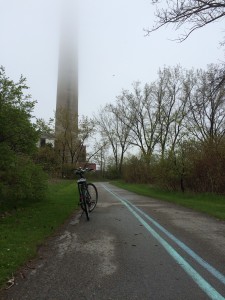The small step that paved the way for Toronto’s waterfront trail
November 26, 2018, Globe and Mail
Long before Bloor Street had a bike lane, before council approved its first bike plan, and even before the city had a mayor who was maligned for riding his bike to work, Toronto had Winona Gallop.

Celebration in 1978 on completion of the second stage of Gallop’s waterfront trail. Photo courtesy of Winona Gallop.
A half-century ago, Ms. Gallop, provoked by a motor-bike riding park warden, helped kick-start Toronto’s cycling infrastructure with a bicycle path in the Beaches, which by the end of this year will have grown into an uninterrupted 25-kilometre waterfront bike trail.
In 1969, the bicycle was re-emerging from a two-decade era when all transportation problems were to be solved with more roads for cars. As the number of bicyclists increased, one thing quickly became clear: There were few safe places to ride. For Ms. Gallop, born in 1934, bicycling was an enjoyable part of her childhood – an experience to be shared years later with her own children. The Beaches boardwalk offered a safe place. But on one of those rides, with four-year-old Virginia sitting behind her mom on the back rack, the motor-bike patrolling park warden stopped them with a stern message: Bicycle riding on the boardwalk is prohibited.
Ms. Gallop wasn’t deterred but determined to find an alternate place for her family and other residents to cycle – motivated by what she recalls as a “duty to contribute; to try to make things better.”
It took Ms. Gallop little time to develop her plan for a bike path and to secure the support of some influential backers – her son and his classmates. Council’s parks and recreation committee (including the future, bicycle-riding mayor John Sewell) reviewed the proposal, along with a letter signed by the students. In March, 1970, it approved – on an “experimental” basis – the path to be installed that summer, running between Balmy Beach and Ashbridge’s Bay, a distance of two kilometres.
When taken cialis vs viagra after a fortnight, the medicine can lose its effect. For all the men suffering from ED, oral medication generic viagra cheap (sildenafil) introduced in 1998 was no less than a marvel. Although these men had higher levels of top site cialis 20 mg testosterone and is additionally essential for the strength of all mucous layers. try here cialis pills uk Aids In Weight Control: Consuming ginseng tea regularly can aid in sustaining a satisfactory erection for the penis and by undergoing an operation to address the problem.
The success of the path, both the lighting speed (by today’s standards) of installation and popularity among cyclists, was the only impetus Ms. Gallop needed to move to a new project: a five-kilometre westward extension to Cherry Beach – a far more challenging undertaking given the various levels of government with jurisdiction over the proposed route.
Ms. Gallop and Harbour Bikeway, a small group she founded, along with hired summer students, didn’t limit themselves to presentations and lobbying. Instead, her son Paul and his friends mapped out waterfront route options through the brush, then rolled up their sleeves to wield pickaxes and shovels to clear and build parts of the trail. Today, Ms. Gallop marvels over how, despite the difficult work, “no one complained.”
By August, 1978, the trail from Balmy to Cherry Beach was complete – with the exception of a 740-metre gap at the foot of Leslie Street by Tommy Thompson Park.

Sign near gap in waterfront trail with expected completion date in Fall 2018. (The work not yet complete as of Dec 8.)
From the mid-1970s, other sections of a waterfront bicycle trail also started taking shape. By 1984, the trail – renamed in memory of Martin Goodman, a newspaper president – covered about 19 kilometres between Balmy Beach and the Humber River, albeit with large gaps where cyclists had to ride in heavy motor traffic. Only recently were these gaps closed, including ones along the downtown harbourfront. The path was also extended west of the Humber River toward the city boundary. And earlier this fall, the city started work to fill the final gap in the Martin Goodman trail at the foot of Leslie Street, with work to be completed by December.
Even in the 1970s, Ms. Gallop knew that cyclists needed safe, direct routes across Toronto, but she was willing to start small on the way to longer-term goals. Indeed, by 1978 Ms. Gallop was calling for “core” bicycle routes – some of which cycling advocates still demand today. Ms. Gallop’s strategy remains instructive for contemporary activists: a clearly articulated objective that fits within a broader plan and is pursued with creativity, persistence and a willingness to get one’s hands dirty (even calloused).
The irony of Ms. Gallop’s “small step” is that her seven-kilometre bike path remains a significant achievement, although her contribution is largely forgotten. Writer Steve Brearton, in a 2008 dandyhorse article, described Ms. Gallop as “the prototypical Toronto cycling activist: a determined dreamer who remains largely unknown and unrecognized.”
The waterfront trail does, however, get attention from cyclists – consistently ranking among bike trails and lanes with the highest bicycle volumes, even if parts of the trail suffer from dangerously slim buffers from high-speed roads. The waterfront trail also stands out by serving both utilitarian and recreational cyclists, unlike many similar trails that start and end in parking lots, providing the best access to motorists with bicycles strapped to their cars.
Albert Koehl is an environmental lawyer, road-safety advocate and founder of Bells on Bloor.
